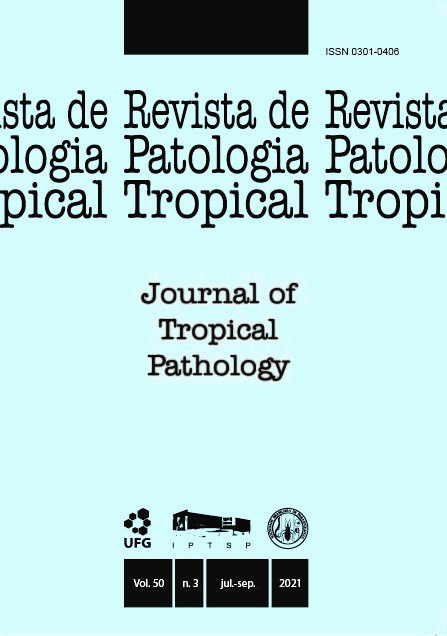High prevalence of protozoan infections: a permanent cycle in a brazilian semi-arid peripheric area
DOI:
https://doi.org/10.5216/rpt.v50i3.68335Resumo
In regions where sanitary conditions are poor, prophylactic administration of antiparasitic drugs is common and affects the prevalence of intestinal parasites, in spite of the environmental maintenance of their life cycle. The purpose of this study was to evaluate the prevalence of parasitic infections, patient lifestyles, health conditions and environmental sources of contamination. One hundred seventy two children and adolescents, 5 to 15 years of age of both sexes were analyzed. Data were obtained through epidemiological questionnaires, parasitological examinations using Paratest®, IgG testing for Entamoeba histolytica, and analysis of sources of contamination in living areas. The study detected a prevalence of 45.9% (79/172) parasitic infections, of which 62.0% (49/79) Entamoeba histolytica/E. dispar complex; 46.8% (37/79) Entamoeba coli; 27.8% (22/79) Giardia intestinalis; 12.7% (10/79) Endolimax nana; 10.1% (8/79) Hymenolepis nana; 8.9% (7/79) Ascaris lumbricoides and 2.5% (2/79) Trichuris trichiura. Out of the 49 samples positive for Entamoeba histolytica complex, there was only one case of antibodies to E. histolytica. The children’s life habits demonstrated inadequate food hygiene practices. These insufficient sanitary parameters revealed a general lack of information in face of an alarming situation regarding sewage and other sources of environmental contamination in 20% of the areas. The high prevalence of protozoan infections despite chemoprophylaxis, with environmental sources of contamination/risk, inadequate health conditions and the general apathy of the population suggest the ineffectiveness of current preventive practices. Thus, it is advisable that control actions include protozoa as therapeutic targets and, above all, health education as a routine practice to prevent the long-term continuance of this vicious cycle.
KEY WORDS: Parasitic infections; chemoprophylaxis; environmental sources.
Downloads
Downloads
Publicado
Como Citar
Edição
Seção
Licença
The manuscript submission must be accompanied by a letter signed by all authors stating their full name and email address, confirming that the manuscript or part of it has not been published or is under consideration for publication elsewhere, and agreeing to transfer copyright in all media and formats for Journal of Tropical Pathology.

